Today’s HR managers know how important it is to train and retain talent, all the while keeping up to date with compliance requirements and ensuring the business is addressing any skills gaps. Using a digital system to help you with this work is a no-brainer, but it’s a crowded market out there so choosing the right one for your organisation can be a time-consuming job.
To help you in your investigations, we’ve rounded up and ranked the top ten training management systems here. We’ve included a summary of their key features and the drawbacks of that particular platform.
What Is Training Management Software?
Training management software (TMS) is a digital platform that automates and streamlines the administration of training programmes.
TMS systems usually help with the following processes:
- Scheduling training sessions.
- Tracking and recording attendance.
- Issuing certificates.
- Reporting on individual, team or company completion rates and progress.
- Automatic notifications of reminders and any other related communications.
- Coordinating different types of training, including online and in-person programmes.
What Is The Difference Between TMS AND LMS?
LMS stands for learning management system. An LMS supports organisations with the creation and delivery of primarily online training courses. In contrast, a TMS focuses on the logistics and administration required to deliver training programmes both online and in real life.
Comparison Chart of Top 10 Training Management Software
| Platform | Key Feature | Best For | Price |
| Factorial | Comprehensive platform for all your HR needs | Growing SMEs with international teams | From £5.40 per user per month |
| Eloomi | LMS with performance review support | SMEs who want a quick set-up | Prices not listed |
| Thrivelearning | Social media design using AI suggestions | Culture-driven organisations | Prices available with demo |
| 360Learning | Peer-driven collaborative learning | Teams with an embedded L&D framework | From £6 per user month (prices in US dollars) |
| LearnAmp | Links performance, training and engagement | UK-based growing teams with a strong L&D focus | Starts from £60 per ‘seat’ per year |
| TalentLMS | Easy for teams to onboard the system | SMEs and start-ups looking for simple support | From £90 per year (prices in US dollars) |
| Kallidus Learn | Compliance-driven training tools | Construction, healthcare and finance organisation | From £300 per month |
| SAP Success Factors | Deliver learning and development on a large scale | Large organisations | Enterprise pricing on request |
| Docebo | AI-powered content curation | Multinational organisations | Enterprise pricing on request |
| Cornerstone On Demand | Connects development, performance and talent recruitment | Corporations with global teams and complex requirements | Enterprise pricing on request |
Top 10 HR Training Management Systems (Ranked)
To help you make sense of the many different training management systems available, we’ve got a ranked list of the top ten programmes here. We’ve included each programme’s key features and also its drawbacks to help you decide which option will work best for your business.
1. Factorial – the Best All-in-One HR & Training Platform
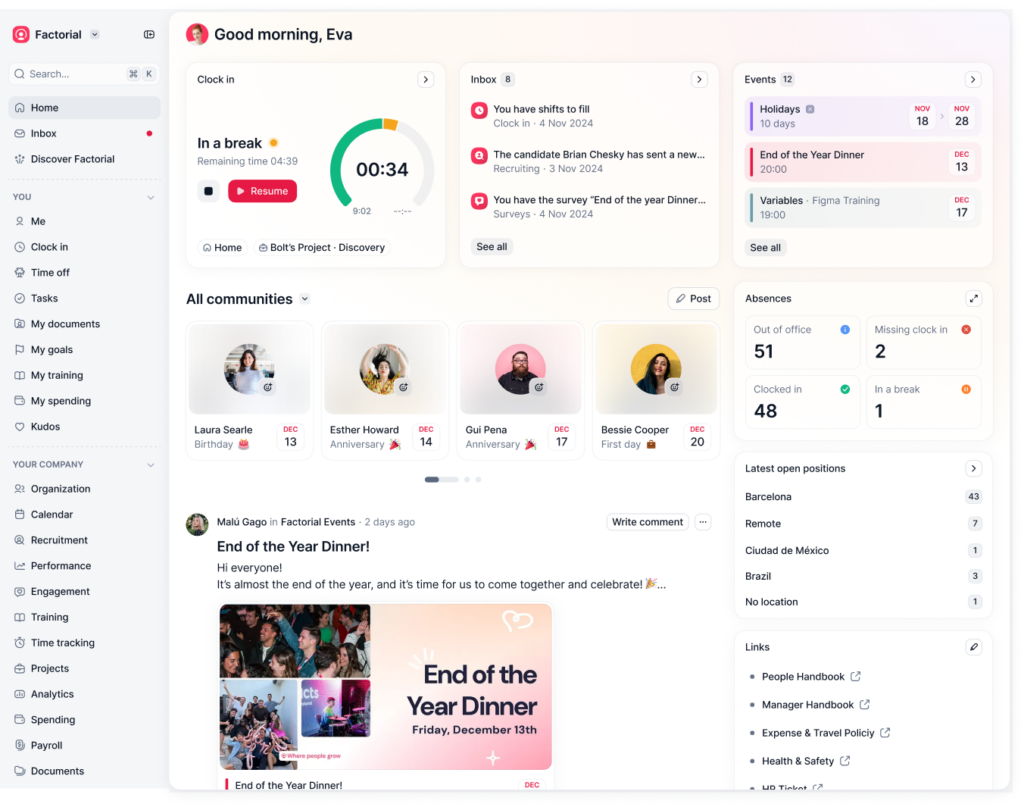
For any organisation focused on creating a culture of continuous learning, Factorial’s comprehensive platform will provide the support your business needs. Its business management software will cover all your HR needs, which means that it centralises training records, performance reviews and compliance requirements in one place. Not only does this centralisation make it quicker and easier to organise the best training for your team, it also means that leaders have a holistic overview of how training is impacting performance.
There is also a native mobile app that allows leaders to respond immediately to requests and employees to access their data and have ownership of their learning journey.
Their training management system supports companies to:
- Identify training needs and meet employees’ training requests.
- Create personalised learning paths for employees.
- Track training progress.
- Create reports to get an overview of the effectiveness of the training programmes.
- Keep on top of mandatory training requirements with alerts.
Drawbacks
As a comprehensive platform, Factorial may be too advanced for companies seeking software solely for training administration. The initial set-up can be a significant investment of time and resources, which may feel like a big commitment.
What Users Say
- Joel from Capterra: “Has great features and really easy to understand the whole points. Training a new comer employee with this product helps a lot as it can show every process step by step, which we loved.”
- Harris from Software Advice: “Provides actionable insights facilitating effective decision making. Gives employees more control over their information, performance analytics and learning management saving time and boosting accountability.”
👉 Try Factorial for free for 7-days! See Factorial in action for yourself.
2. eloomi
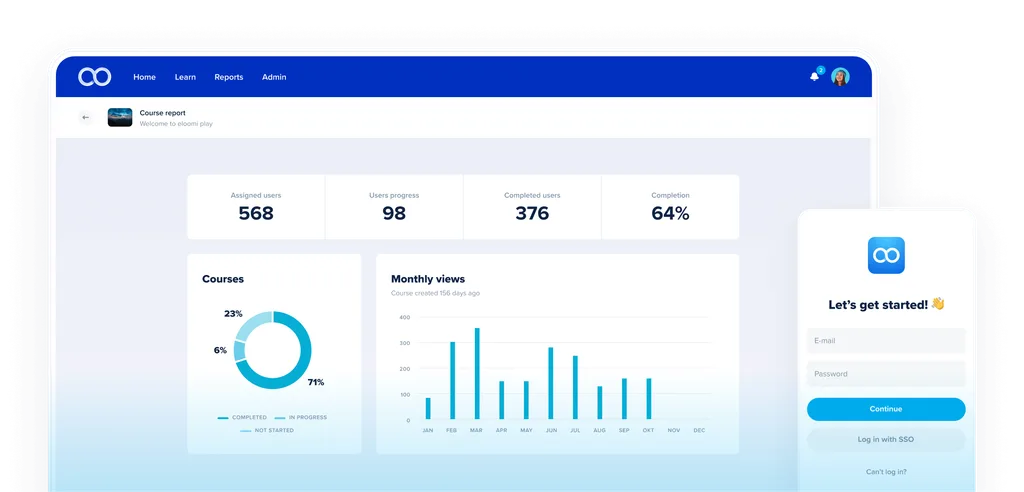
Eloomi is a user-friendly LMS that includes training content and tools to support the logistics of managing your training programme. Like Factorial, it has a native mobile app that allows employees to complete their training requirements on the move.
Eloomi’s key features include:
- An intuitive interface makes onboarding the system straightforward.
- Curated training courses searchable by skill.
- Performance review support to connect training requirements with objectives.
- Skill mapping tools help organisations identify existing skills and gaps.
- SCORM-compliant so the programme can integrate with other LMS.
Drawbacks
Eloomi does not list its prices on the website, so organisations cannot understand the cost implications of the model without engaging with sales representatives first. In addition, some users report that the interface for admins lacks the flexibility ideally required.
What Users Say
- Annie from Software Advice: “I was looking for a learning management system (LMS) that would help me manage my online courses. I decided to go with eloomi because they offer a system that is simple, easy to use, and affordable.The eloomi dashboard is easy to navigate and it’s easy to create course content.”
- Laura from Capterra: “Overall Eloomi does what it should, we have training content on the system and have managed to build an induction for the company. However the system is difficult to use, when creating your own content the system glitches at times and means that the answers that should be right on quizzes aren’t which mean extra time spent editing.”
3. Thrive Learning
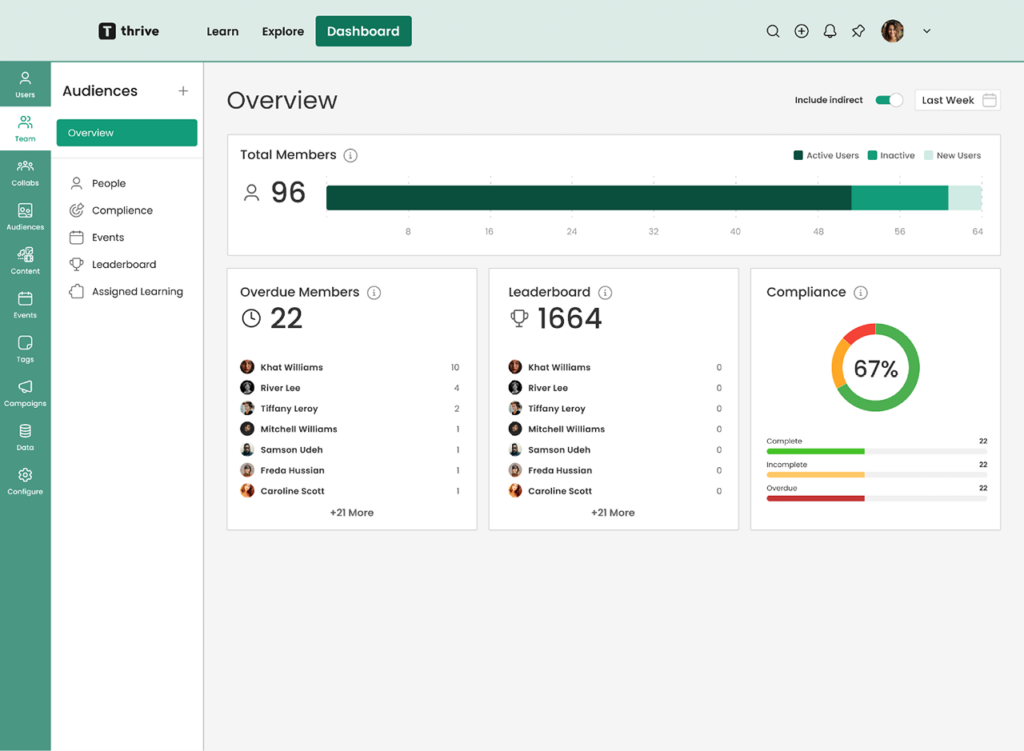
Thrive Learning uses a social media design and AI-powered personalisation options to maximise how employees engage with their learning. The platform also provides traditional LMS functionality by delivering training content, automating the processes involved in training programmes and providing accurate record keeping.
The key features of Thrive include:
- Social-style feeds to encourage engagement.
- An AI tool called Kiki supports individual employees’ learning journey.
- The system provides training for compliance and skills-based needs.
- Analytics dashboards and in-depth reporting tools.
- SCORM-compliant.
Drawbacks
As Thrive has a less conventional LMS structure, some organisations might feel its design and ethos aren’t quite right for them, especially if traditional compliance is a significant part of the organisation’s requirements. The more advanced features come at a higher price point.
What Users Say
- Abbie from G2: “All content is centralized and easy to search learning resources. The content contains gamification elements and modern/relevant content to reflect current events. Lots of webinars and events to join to ensure the most is made of the platform.”
- Saheeb from Capterra: “The simplicity of it’s use and the blended multi modal approach is great. Also the content club is niche and a product which really has met our needs. [However,] the quantity and variety of content is limited compared to competitors.”
4. 360Learning
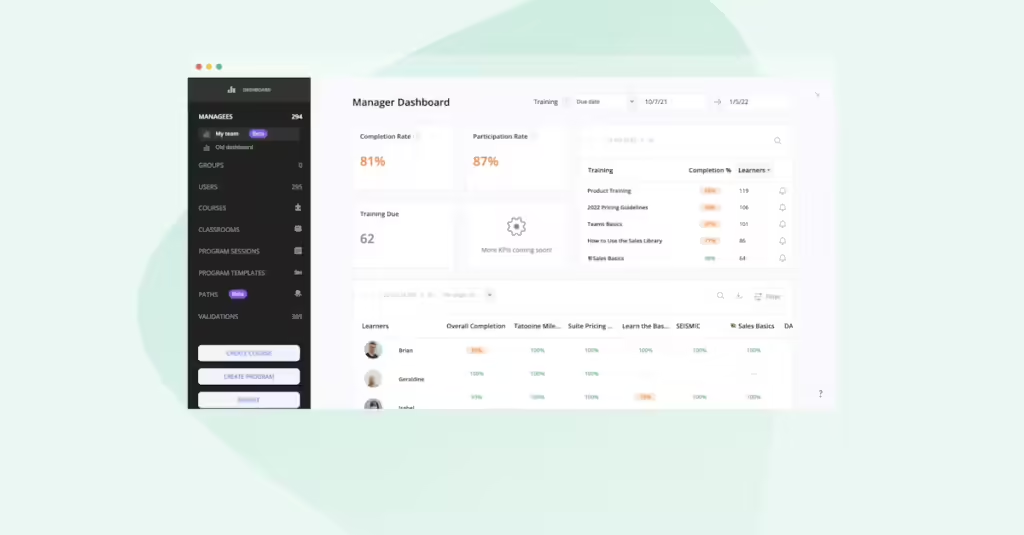
360Learning is an LMS platform that supports teams to create and deliver peer-sourced training content as well as provide access to other types of training. The system puts collaboration and sharing knowledge at its heart while also helping to automate processes, identify skills gaps and ensure compliance requirements are met.
360Learning’s key features include:
- Authoring tool for collaborative course creation.
- Facilitates group-based learning.
- Integrates with other content systems.
- Version control and course versioning to avoid duplication.
- Surveys and other engagement tools.
Drawbacks
360Learning relies on workforce engagement to maximise its full potential, making it less ideal for companies without a fully integrated internal learning and development framework embedded in the company culture.
What Users Say
- Linh from G2: “Navigating through the various features and modules is intuitive, making it a breeze to find what I need. The clean and modern interface is a real plus, as it minimizes distractions and allows me to focus on the learning material. While I appreciate the platform’s design, I feel the current learning content is somewhat limited. I wish there was a broader range of topics and more in-depth material available”
- Agate from Capterra: “There is no catalogue of e learning module available that we could use/buy it could be useful to reach the support by chatting online whenever we need It could be nice to have pre established e learning path per role, in several languages.”
5. Learn Amp
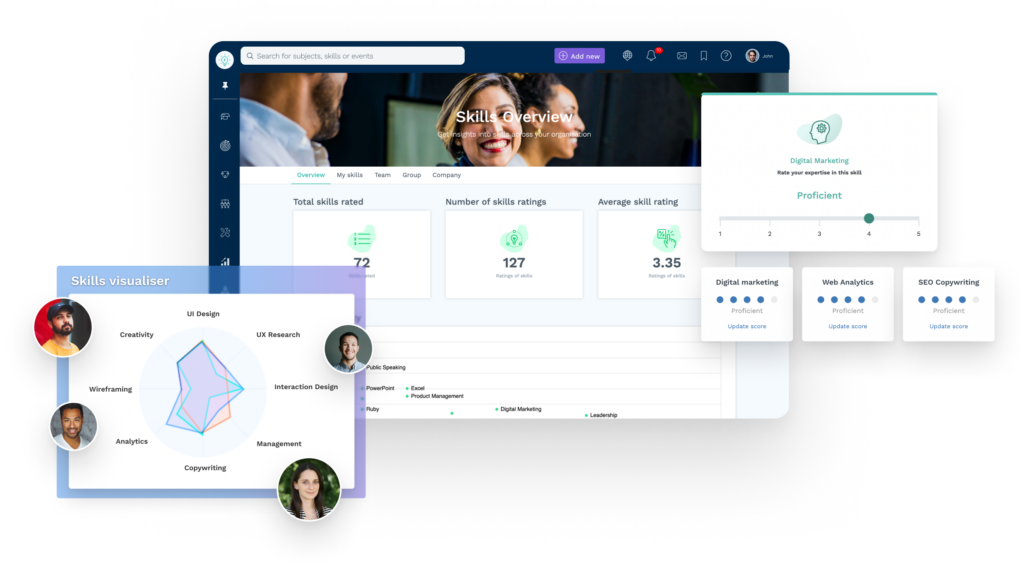
Learn Amp aims to connect the workforce community, help them learn and encourage their personal and professional development by providing direct links between performance reviews and training plans and tools to promote engagement. The system is easy to access and intuitive to use, and can handle the natural growth in requirements of expanding teams.
The features of Learn Amp include:
- Personalised employee development plans
- Ability to create surveys, quizzes and other interactive tools to check understanding.
- Integration with other content models.
- Tools for communities and academies to share learning.
- AI-enabled tools support skills information gathering.
Drawbacks
Learn Amp’s many features can be complex to onboard without the proper support and commitment, making it a less suitable option for smaller teams with fewer training requirements.
What Users Say
- Darcie from G2: “Learn amp is a very user-friendly, sophisticated LMS platform with many fantastic features. I like how simple it is to use, build and curate.”
- Michael from Capterra: “The platform is extremely easy to navigate, reporting functionality is excellent, logical and comes with very good quality content at a very reasonable price.”
6. TalentLMS
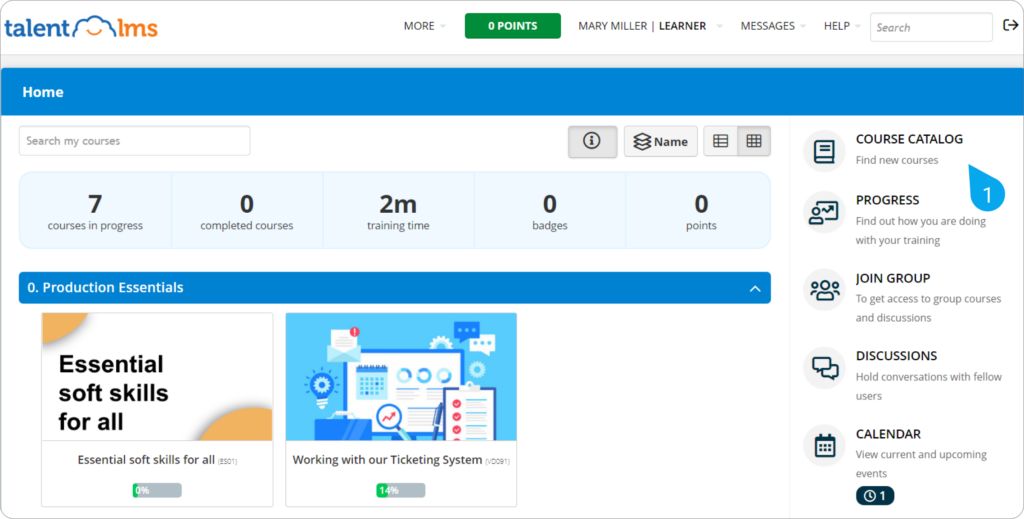
TalentLMS is another system that offers tools to create the content required for training programmes as well as support for the administration requirements involved. The system will automate processes, making learning more fun and provide reports to track overall progress. There is also a mobile app.
TalentLMS’s key features include:
- Customisable learning pathways supporting skills-based blended learning.
- An intuitive and accessible interface makes it easy to get the system up and running quickly.
- Built-in assessment process and certificate generation
- AI tools to support course creation.
- Gamification of training to encourage better engagement.
Drawbacks
For larger companies, the customisation and reporting options can feel more limited than ideal. Similarly, the course generation tools could support more creative and personalised approaches, which would enhance the learning environment.
What Users Say
- Katie B. from G2: “Love the ease of use and the small learning curve to get everything up and running. And have loved having the dedicated onboarding specialist.”
- Jonathon from Capterra: “Ease of use and ability to white label so builds credibility into our company offering. We have had a few minor UX issues but customer support have always sorted this quickly for us.”
7. Kallidus Learn
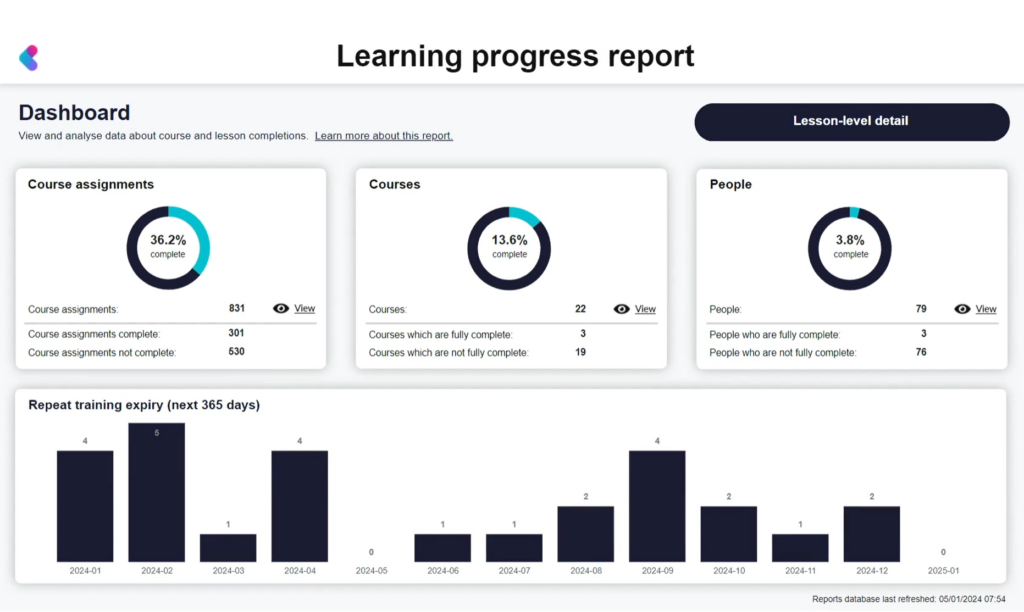
Popular with compliance-driven sectors such as construction, finance and healthcare, Kallidus Learn is a robust platform with an intuitive design that streamlines compliance throughout an organisation. The system integrates with other HR systems and has dashboards that allow managers to track compliance progress in real-time.
The key features of Kallidus Learn include:
- Strong systems for tracking compliance and CPD requirements.
- System links to performance reviews to address skills gaps.
- An off-the-shelf catalogue of online courses is available.
- ‘The Academy’ provides e-learning, events and health checks.
- Responsive customer support.
Drawbacks
Kallidus has a pricing structure which can make the system feel more expensive as you add on features and grow your business. Some users find the interface less user-friendly than others, with more limited customisation and integration options.
What Users Say
- Deborah from Software Advice: “The user interface is very well designed and personal The Admin console. [However,] creating a new course is time consuming: – Having to create first the parent course, then having to create a lesson, then finally creating an event in order to publish the course to users.”
- Robert from GetApp: “Ease of use for learners, easily navigable even for users with lower levels of technical ability. [But, the] back end is not as intuitive as it could be, however still better than other LMSs I have used.”
8. SAP SuccessFactors Learning
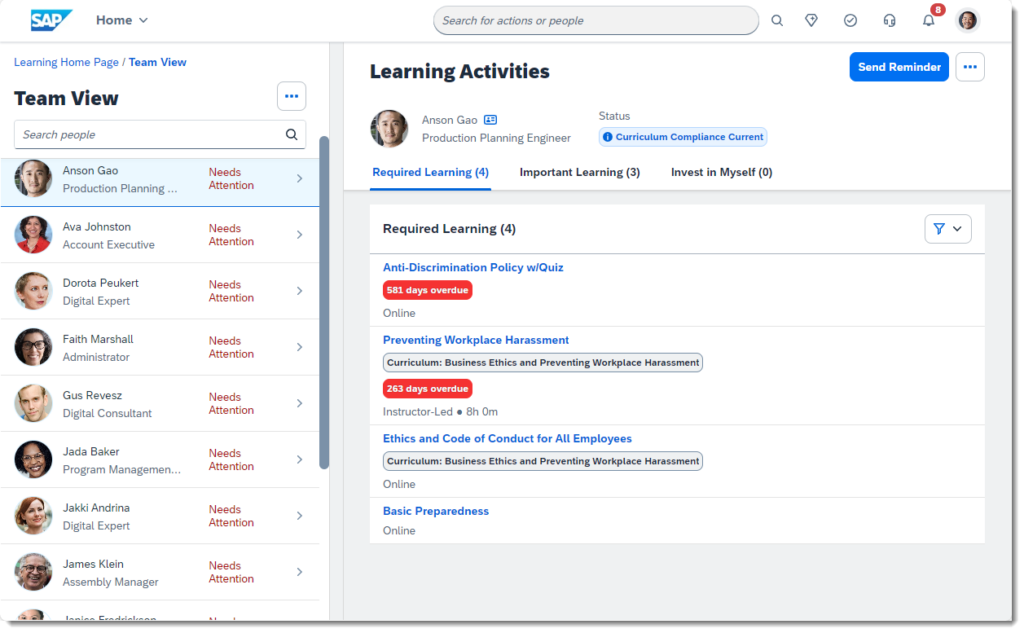
SAP SucessFactors Learning is a robust LMS designed for larger organisations already using SAP products. It integrates learning and development needs with the broader strategic HR goals for businesses such as performance and talent management, as well as supporting the administrative processes for the core HR function.
The key features of SAP SuccessFactors Learning include:
- Compliance tracking tools.
- A design that boosts employee engagement with unique experiences for each user.
- Supports a range of training content via partnerships, integrations and built-in tools.
- AI-driven skills framework, the travel intelligence hub.
- Mobile app so learners can access training content wherever they are.
Drawbacks
As SAP SuccessFactors Learning is part of the comprehensive suite of SAP products, it can be too expensive and complex for smaller organisations to get value for money.
What Users Say
- Written on Gartner: “One stop place for all unified learnings which can also include external platforms ie Linkedin learning.”
- Written on Gartner: “SAP Successfactors learning is really great platform for learning & skill set improvement. Our organization has custom made courses & videos for learning purpose.”
9. Docebo
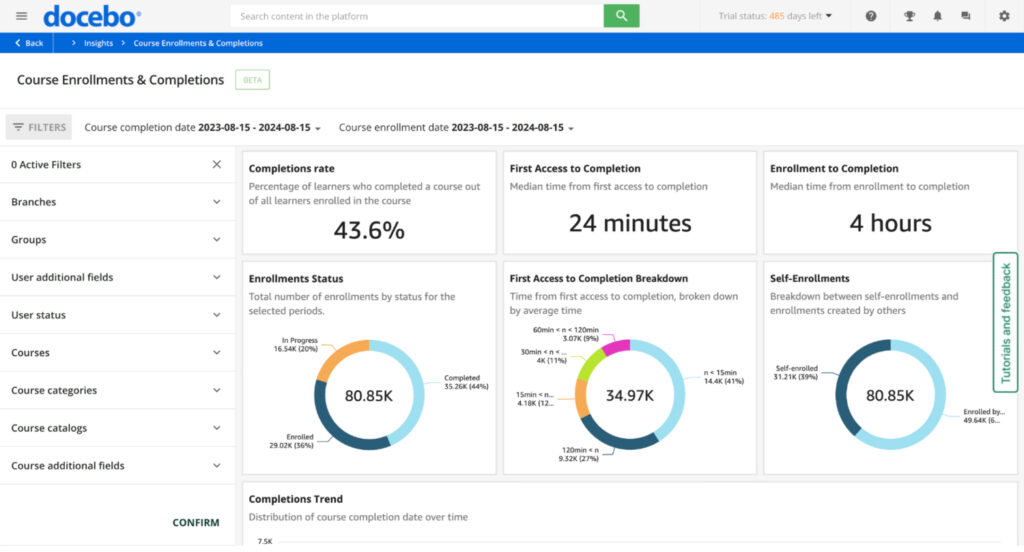
Docebo is an AI-driven LMS designed to meet the complex and extensive training requirement of business with a large number of employees, multiple departments and often international operations.
The key features of Docebo include:
- A personalised learning platform driven by AI.
- Detailed insights using customised dashboards and in-depth reporting tools.
- Integration with existing software, other applications and websites.
- The ability to scale as the business grows.
- Pre-designed templates available for easy course creation.
Drawbacks
Similar to Sap SucessFactors Learn, the main drawback of using Docebo is the fact is designed for large companies who have the resources to maximise the different features. For small and medium-sized business, Docebo can be too expensive and complex.
What Users Say
- Mateusz from G2: “The platform allows for flexibility in how we deliver the learning experience, it performs rather well without frequent bugs or crashes – stability is really important for us in the organization. The experience with customer representatives is also quite positive.”
- Kevin from G2: “I like how easy it is to use—both for admins and learners. The interface is clean, and it’s simple to create learning paths and track progress. Integrations with other tools are also super helpful. Some parts can be a bit tricky to set up at first, especially custom reports or workflows. Also, support response times could be better.”
10. Cornerstone OnDemand
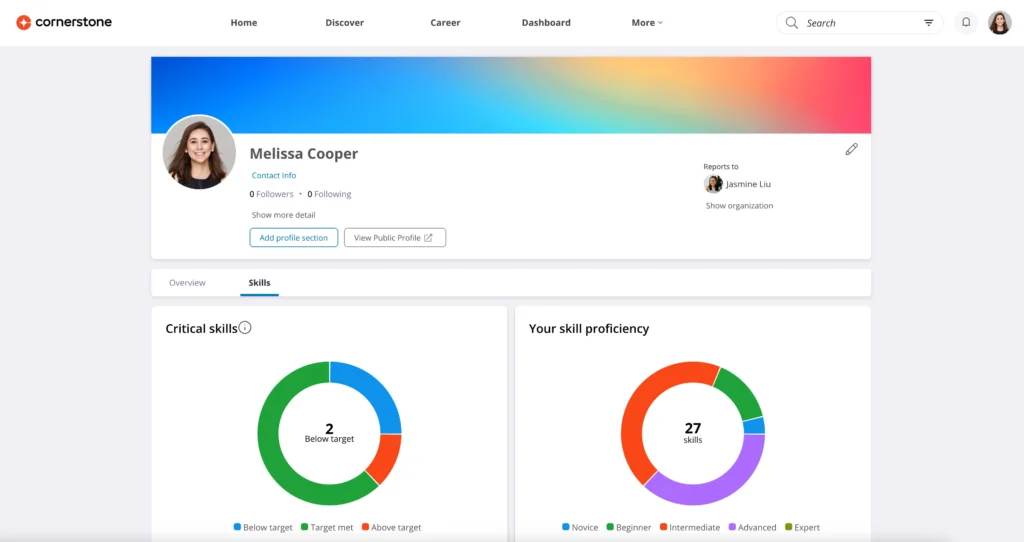
Part of the Cornerstone software suite which supports learning, performance and talent management, Cornerstone OnDemand is an LMS designed to support large organisations focussed on skills development for future needs.
The key features of Cornerstone OnDemand include:
- Integrates with recruitment software.
- Courses include instructor-led and virtual classrooms.
- AI-driven support through Cornerstone Galaxy AI.
- Access to extra modules to support further options for development.
- SCORM/xAPI/AICC-compliant for all eLearning formats
Drawbacks
As it is designed to support large business, the onboarding and training involved in using Cornerstone OnDemand can be a big investment for smaller businesses.
What Users Say
- Written on Gartner: “Cornerstone overall has been a great resource for the company. With it offering more than just compliance training and standard reports. We are still learning about what all Cornerstone has to offer and hope to simplify our systems with Cornerstone and keep all our trainings, events, and materials all in one place.”
- Joe from G2: “Ease with we could set up different curriculums, load videos, and reports to track employee completion. [However,] complex configuration options try to consider every way the product is used. The configuration options were sometimes tricky to navigate.”
Why HR Teams Need a Training Management System Today
In 2026, there are several reasons why a training management system benefits organisations:
Saves Time And Creates Efficiencies
Using manual systems to organise, deliver, track and record training requirements takes time. By automating these processes, employees involved in implementing learning and development programmes can free up their time to focus on more strategic tasks, such as thinking about and planning for future skills needs.
Ensures The Business Meets Compliance Requirements
Issues around compliance can be a significant risk to a company. A digital system that can track training needs, schedule and record training, and issue certificates reduces the chance of costly or dangerous errors. It also allows companies to be audit-ready.
Brings Consistency To Development Plans
Using a digital system enables the whole company to adopt a unified approach to development, ensuring that everyone has a career plan and access to the systems in place to support their training needs to achieve it. A unified approach can also support company-wide engagement because everyone understands the expectations for learning and development.
Provides Insights Into Progress And Performance
Training management systems enable companies to efficiently collate data, analyse how performance relates to existing skills, and identify gaps and training needs. These insights are essential to drive business growth and to ensure that organisations have people with the right skills for their strategic plans.
Choosing the Right HR Training Management System for 2026
Choosing the right training management system for your organisation’s needs depends on what your priorities are. For some businesses, compliance is key. For others, the goal is to get employees engaged and drive a culture of continuous learning. Ask yourself what your company needs and what platform could you get the most use out of.
If your priority is to integrate the management of your training requirements into your broader approach to HR as your business grows, a comprehensive and intuitive system like Factorial is your best fit. An all-in-one platform that ensures professional growth and compliance. With a robust tool like Factorial, you’ll be sure to boost your productivity levels by closing the skill gap, investing in your team, and creating a positive work environment. In addition, you’ll have all your other core business functions readily available to manage from the same platform. From expenses and payroll to time tracking and holiday requests – see Factorial in action for yourself!
The information presented on this page is based on publicly available sources and not limited to eloomi.com, thrivelearning.com, 360learning.com, learnamp.com, talentlms.com, kallidus.com, sap.com, docebo.com, cornerstoneondemand.com, Capterra public reviews, G2 public reviews, and trustpilot public reviews. The comparisons between Factorial and other providers, are intended solely for the illustration of the respective software features, pricing and functionalities. All information regarding features, prices, and integrations may be subject to change without prior notice. Factorial assumes no liability for the accuracy, completeness, or timeliness of the information presented. We recommend contacting the respective providers directly to obtain the most accurate and up-to-date information. All legal regulations regarding spanish fair advertising and competition law are fully observed by us; if you have any concerns, please reach out to us. The comparisons presented do not constitute a final evaluation or recommendation for any provider, but serve solely as an informational source.


